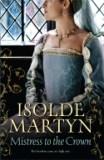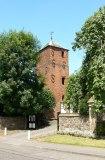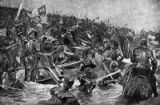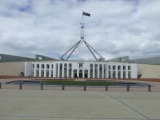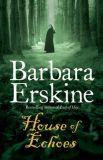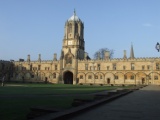It is a tradition in the NSW branch that at the August general meeting we have “Scrabble Talks”. Once a year, members draw Scrabble tiles out of a bag and then prepare a short talk on a topic starting with their letter. The following is Judy’s talk on ‘Duchess Anne of Exeter’. This was a particularly fitting, as the day before our meeting was Duchess Anne’s birthday.
Duchess Anne of Exeter
I’ve been allocated the letter ‘A’ for my talk at the August general meeting of the NSW branch, so I would like to tell you about Princess Anne Plantagenet, better known as Duchess Anne of Exeter, who was the eldest sister of Edward IV and Richard III and apparently Edward’s favourite sibling. You will be familiar with this memorial brass to Anne and her second husband, which I think is the only likeness of her to survive.
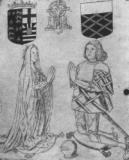
Anne’s story is a very good example of a high born woman who became a pawn in the political manoeuvres of her male relatives. But we can presume she found happiness towards the end of her life.
Anne was born in 1439 and was the eldest surviving child of the Duke of York and Cecily Neville. She was betrothed in 1445 at the age of 6 years to Henry Holland, who was 15 years old and the son of the Duke of Exeter. York paid a huge dowry of 4,500 marks, the largest known in late medieval England. Within five years of this, you will recall, was around the time that the King, Henry VI, began showing signs of his illness and the Wars of the Roses was beginning to seriously foment. It is believed York’s motive in securing the betrothal was partly political and he was hoping for Exeter’s alliance in his attempt to return to France. It was also a dynastic move as Exeter was the next closest male relative of Henry VI and descended from John of Gaunt and Blanche of Lancaster. York took the opportunity to combine two great dynasties but in fact, in both personal and political terms, it was a disaster.
Anne and Henry married soon after their betrothal and Henry inherited his father’s titles and land in 1450 and as the Duke of Exeter and became admiral of England, Ireland & Aquitaine and Constable of the Tower of London. Their first and only child, also called Anne, was born in 1455, and she went on to marry Elizabeth Woodville’s son, Thomas Grey in 1467. The young Duke of Exeter, Henry, was described as an unappealing character, violent, cruel and lacking in any real experience and was unintelligent – not the makings of a great husband or political ally!!
During York’s Protectorate in 1453 – 54, young Exeter (York’s son-in-law) played a prominent role in the serious breakdown of local law and order and the uncontrollable violence, particularly in Yorkshire which was York’s biggest challenge during his protectorate, seems to have been perpetrated by Exeter himself. Exeter planned a major uprising in the north and may have even plotted to murder York by luring him to Yorkshire.
It was unlikely that Duchess Anne was able to escape the animosity Exeter felt towards his wife’s father, given his character. In addition, York defaulted on the later instalments to her dowry, which is understandable but would not have helped the relationships. Anne did have a child with Exeter in 1455 but we can presume that the marriage broke down soon after.
Exeter was a staunch Lancastrian during the descent into Civil War and he became a very bitter enemy of York and the Nevilles. Exeter thought, as the King’s closest relative, he was entitled to a prominent role in government and he was not happy when York began to advance his own claims as King Henry’s heir presumptive. As a committed Lancastrian, Exeter joined forces with Somerset, Northumberland and others in opposition, which culminated in the death of York, his son Edmund and brother-in-law Salisbury at Wakefield in 1460.
In 1461 Exeter fought for the Lancastrians at the battles of Blore Heath, Northampton, St Albans and Towton and even though defeated, he continued to be aligned with the Somerset and the other hard-core Lancastrians. This caused further and continuing difficulties for the new King Edward in his attempts to establish his rule and find a collegiate solution to the regional turmoil caused by the civil war. Exeter escaped overseas and was attainted by parliament and his estates were granted to his wife – one advantage of being the new King’s sister. Exeter lived in poverty during his exile until the Duke of Burgundy gave him a modest pension. But remember that the Duke of Burgundy was soon to become Edward’s brother-in-law when he married Princess Margaret of York.
Anne at this stage was still married to Exeter and was herself the second lady in the land after the King’s mother, Cecily.
Anne, around this time, began a relationship with Sir Thomas St Ledger who became her lover (who could blame her!!). Thomas was made an esquire of the body to Edward IV and was granted eight manors in Buckinghamshire and Cambridgeshire, including a royal manor, and received a number of other wardships and grants. Here, and in the granting of Exeter’s estates to her, Anne benefited considerably from being the King’s sister.
Thomas proved to be a loyal member of the King’s household, he resisted Clarence and Warwick in 1469 – 1470 and he even joined Edward in exile in 1470.
But, not to be forgotten, that flea Exeter returned to England and commanded the left wing of Warwick’s army at Barnet in April 1471 and in doing so opposed his 3 brothers-in-law, Edward, Richard & Clarence. He was seriously wounded on the battlefield but eventually recovered to be imprisoned in the Tower of London. Anne finally got her divorce from Exeter and she married her lover Thomas St Ledger the next year.
But Exeter was not to be put down so easily, he was released from custody in 1475 to join Edward’s French expedition but on the return journey he drowned in the English Channel, reputedly thrown overboard with the King’s knowledge. A fitting end for such a despicable character. I wonder what Anne thought??
Tragically for Anne, though, her daughter with Exeter died the same year.
The next year in 1476, Anne gave birth to a second daughter also called Anne, but unfortunately Duchess Anne herself died, probably in childbirth. The infant Anne, whose father was Thomas St Ledger, was to marry George Manners and become the Baroness Ros and have two children, one of whom became the 1st Earl of Rutland. This title has remained in their family until today – Duchess Anne and her lover Thomas had established a very successful and long lasting dynasty.
But to continue the story of the people in Duchess Anne’s life: after Edward’s death in 1483, Anne’s second husband Thomas St Ledger attended Richard III’s coronation but in July of that year he was dismissed from all posts. He became closely aligned with Thomas Grey, Marquis of Dorset, and a leader in the Buckingham Revolt around Exeter and held out against the royal forces at Bodmin Castle until mid-November. Thomas St Ledger was executed a few days after. How sad for Anne, but we do not truly understand the circumstances of this period and cannot understand the extremes of emotion that Edward’s old household felt given the events which followed Edward’s death and Richard’s subsequent coronation.
We also do not know much about Duchess Anne as a person, which is not unusual for women of this period. However in 1491 her daughter by her second husband Thomas, founded in her honour the Rutland Chapel, as it is now called, in the north transept of St George’s Chapel at Windsor, just down the aisle from Edward IV’s vault. The memorial brass to Anne and Thomas is on the east wall of this chantry chapel.
The Chantry, although established for her parents, also contains a fine tomb chest and alabaster effigies of Anne junior and her husband George Manners, the 12th Baron Ros. These effigies are very fine examples of the period. (You can find photographs of these here)
The Rutland Chantry is a beautiful place to visit and is still used regularly for services at St George’s Chapel. It has some very beautiful new tapestries hanging within, along with some new furniture and today remains a very peaceful place of worship and contemplation. A fine memorial to Duchess Anne.
Tags: Edward IV, Family, Richard III, Wars of the Roses
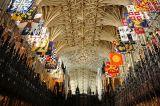 The choir of St George’s Chapel, Windsor (photograph by Josep Renalias, obtained through Wikimedia Commons)
The choir of St George’s Chapel, Windsor (photograph by Josep Renalias, obtained through Wikimedia Commons)